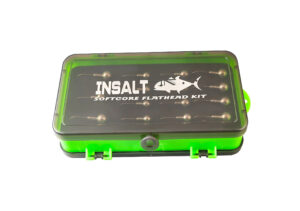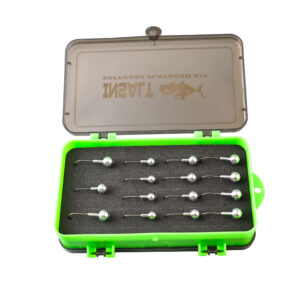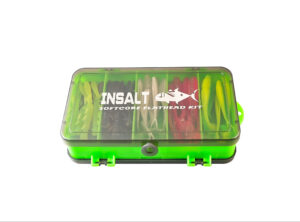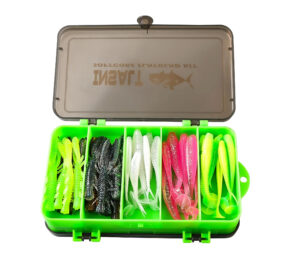Targeting Flathead on Soft Plastics: The Ultimate Guide for Aussie Anglers
Flathead are one of Australia’s most accessible and exciting sportfish, found from estuaries to shallow bays across the country. Their ambush predator nature, willingness to hit lures, and excellent eating quality make them a favourite target for lure anglers. Soft plastics have become the go-to method for consistently landing flathead due to their versatility, lifelike action, and adaptability to various environments.
In this article, we’ll break down everything you need to know to consistently catch flathead using soft plastics—whether you’re fishing the shallows of the Gold Coast, the sandbanks of the NSW South Coast, or the flats around Port Phillip Bay.
Understanding Flathead Behaviour
Flathead are classic ambush predators. Rather than chasing down prey like pelagics, they prefer to lie in wait—partially buried in the sand or mud—until an unsuspecting baitfish, prawn, or crab comes close. When it does, they strike with impressive speed.
Key behavioural traits:
-
Habitat: Sandbanks, drop-offs, weed edges, estuary channels, and drains.
-
Feeding times: Best during the run-out tide as bait is forced off the flats.
-
Feeding habits: Opportunistic—will eat fish, prawns, crabs, worms, and just about anything that fits in their mouth.
-
Strike zone: Flathead usually hit from below and behind, so slower retrieves and pauses often work best.
Best Gear for Soft Plastic Flathead Fishing
Choosing the right gear is crucial for detecting subtle bites, working your lure effectively, and landing fish—especially those metre-plus crocs.
Rods
Look for a rod that provides good sensitivity with enough backbone to drive home a hook set. Flathead often inhale the plastic and sit still—meaning you need to feel the bite and strike quickly.
Recommended specs:
-
Length: 6’6” to 7’2”
-
Power: 2-5kg (or 4-8lb), medium-light
-
Action: Fast taper for quick hook sets
Great options:
-
Insalt Flickstick 6–12kg – for those chasing trophy flathead or fishing deeper water
-
Shimano Zodias 2–5kg
-
Daiwa TD Black or Rebellion 3–6kg
Reels
A 2500 to 3000-size spin reel balances light casting and drag control. Look for smooth drag systems to avoid tearing the hook during sudden head shakes.
Top picks:
-
Daiwa Fuego LT 2500
-
Shimano Stradic FL 2500 or 3000
-
Insalt ReelMate 3000 (solid mid-tier option for Aussie conditions)
Line and Leader
-
Braid mainline: 6–10lb braid offers casting distance and sensitivity.
-
Leader: 10–14lb fluorocarbon is ideal; step up to 16–20lb for heavy structure or big fish areas.
Choosing the Right Soft Plastics
Flathead aren’t too fussy, but selecting the right profile and presentation boosts your catch rate significantly.
Plastic Styles That Work
-
Paddle Tails
Imitate baitfish with a seductive tail thump. Ideal for covering ground.-
Sizes: 3–5 inch
-
Popular: ZMan MinnowZ, Berkley PowerBait Power Minnow, Insalt Softcore Paddletail
-
-
Curl Tails
Offer action even when the lure is stationary. Deadly on shutdown fish or in winter.-
Sizes: 2.5–4 inch
-
Popular: Gulp Grub, ZMan GrubZ
-
-
Jerk Shads / Split Tails
Ideal for twitching and darting retrieves, simulating wounded bait.-
Sizes: 4–6 inch
-
Popular: Gulp Jerk Shad, Keitech Easy Shiner
-
-
Creature Baits / Shrimp Imitations
Perfect for flats or dirty water where prawn and crab imitations shine.-
Sizes: 2–4 inch
-
Popular: Insalt Softcore Critter, Gulp Shrimp
-
Colours That Work
-
Clear Water: Natural baitfish colours like silver, motor oil, watermelon, and pumpkinseed
-
Dirty Water: Chartreuse, pink, nuclear chicken, and white
-
Low Light: Black/gold, purple, or darker colours for silhouette
Scented Plastics
Gulp! and Pro-Cure-scented plastics excel when the bite is tough. Flathead often hold on longer to scented baits, giving you more time to set the hook.
Matching Jigheads to Conditions
Using the right jighead is crucial for presenting your soft plastic naturally. Too light, and you won’t reach the strike zone. Too heavy, and it loses its lifelike action.
General Jighead Guide
| Depth | Jighead Weight |
|---|---|
| 0.5–1.5m | 1/16 – 1/8 oz |
| 1.5–3m | 1/8 – 1/4 oz |
| 3–5m | 1/4 – 3/8 oz |
| >5m | 3/8 – 1/2 oz |
Hook size: Match hook size to your plastic length.
-
2/0 for 3” plastics
-
3/0–4/0 for 4”–5” plastics
Best types:
-
TT HeadlockZ
-
Insalt Lethal Lock Jigheads
-
Berkley Nitro
Retrieve Techniques for Flathead
Flathead respond best to lures that bounce and pause on or near the bottom—just like injured prey.
1. Standard Hop and Pause
Steps:
-
Cast and let the plastic hit bottom.
-
Lift the rod tip with two short hops.
-
Pause for 1–3 seconds.
-
Repeat.
Flathead often strike during the pause, so stay alert for pressure or taps.
2. Slow Roll with Occasional Lift
Ideal with paddle tails or curl tails.
-
Slowly retrieve the plastic across the bottom.
-
Add a subtle lift or twitch every few cranks.
-
Pause occasionally.
This mimics a struggling baitfish or prawn crawling along the bottom.
3. Aggressive Jerk for Reaction Bites
Used in deeper water or when targeting big fish.
-
Sharp rod twitches to dart the plastic.
-
Pause for 2–3 seconds.
-
Watch line for ticks or movement.
Flathead often react to the sudden movement and inhale the lure.
Best Locations to Target Flathead
Flathead inhabit diverse habitats, but knowing the structure and tide movements is key to finding fish consistently.
Estuary Drop-Offs
-
Fish along the edge where shallow flats drop into deeper channels.
-
Best during run-out tides.
Sandbanks and Mudflats
-
Ideal during incoming tides when flathead push up to hunt.
-
Target drains, depressions, and yabby beds.
Weed Edges
-
Flathead often sit just outside weed lines waiting for prey.
-
Fish paddle tails along these edges with a steady retrieve and pause.
Bridge Pylons and Rock Walls
-
Use heavier jigheads to get your lure to the bottom.
-
Work the structure thoroughly with slow hops.
Tides and Timing
Tide plays a huge role in flathead fishing. A falling tide concentrates bait into predictable locations, making fish easier to find.
-
Best tide: Run-out tide, 2 hours after high to low
-
Moon phase: Leading up to the new and full moon offers better movement
-
Time of day: Early morning and late afternoon offer the best light conditions
Flathead on the Flats: A Visual Game
Shallow flats in less than a metre of water can be visual fishing heaven. You’ll often see flathead lies (impressions in the sand), bait movement, and even fish tailing.
Tips:
-
Use weedless rigging in thick seagrass.
-
Go light—1/16 oz jighead and 6lb leader.
-
Look for bait flicks or stingrays—flathead often follow them.
Upgrading for Trophy Flathead (80cm+)
To target true crocs:
-
Use larger 5–7 inch jerk shads or paddle tails
-
Upgrade leader to 16–20lb
-
Fish deeper water edges (5–8m)
-
Use sounders to locate bait schools or drop-offs
These larger fish often sit deeper and are more solitary, requiring patience and precise presentation.
Catch and Release Tips
Flathead are a great table fish, but the big females (70cm+) are prime breeders and best released.
-
Always use a rubber landing net
-
Avoid touching gills or eyes
-
Support the fish horizontally for photos
-
Remove hooks gently using long-nose pliers
-
Release quickly and in calm water
Common Mistakes to Avoid
-
Too fast a retrieve: Flathead prefer slower presentations with pauses.
-
Lure too small for big fish: Don’t be afraid to throw 5–6 inch plastics.
-
Fishing during slack tide: Movement is key—choose the 2 hours either side of peak movement.
-
Neglecting scent: Especially in tough conditions, scent can make all the difference.
Conclusion
Targeting flathead on soft plastics is one of the most rewarding and accessible forms of lure fishing in Australia. With the right gear, lure selection, retrieve style, and understanding of tides and terrain, you’ll be well on your way to consistent success.
Whether you’re flicking a 3” paddletail across a shallow estuary sandbank or hopping a 5” jerkshad down a deep channel edge, the flathead’s willingness to smash a plastic lure is what keeps Aussie anglers coming back for more.
Master these fundamentals, stay mobile, and fish the tides—and you might just land that elusive metre flatty.




